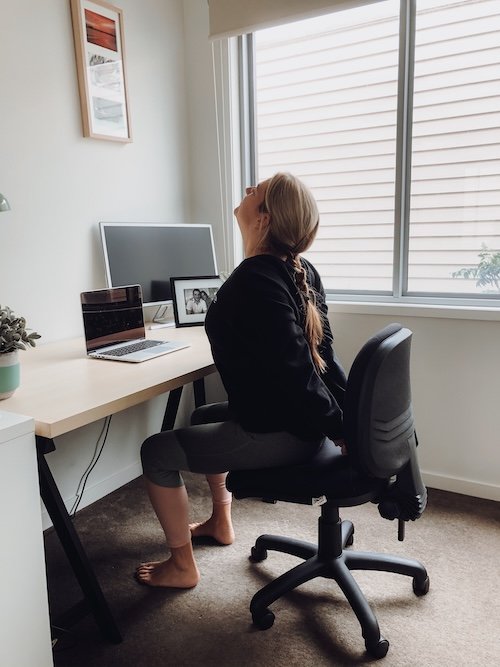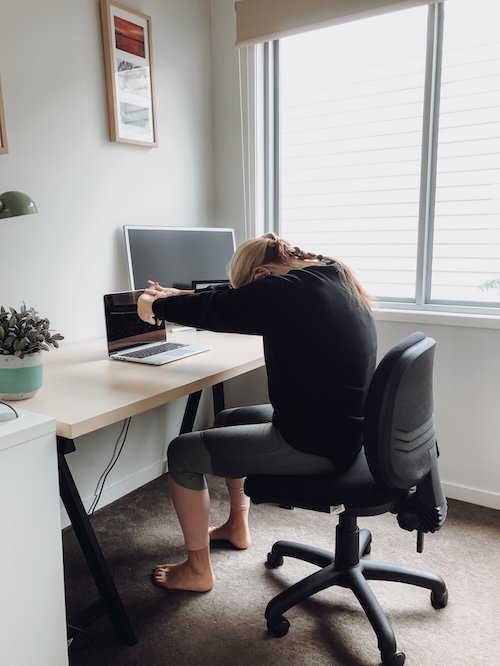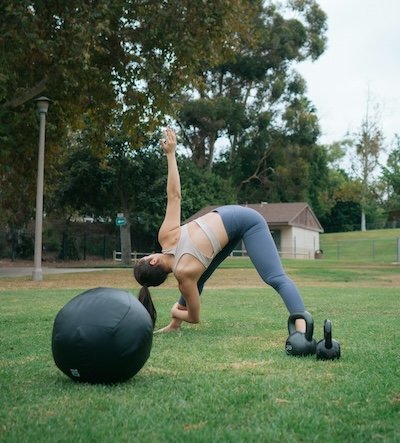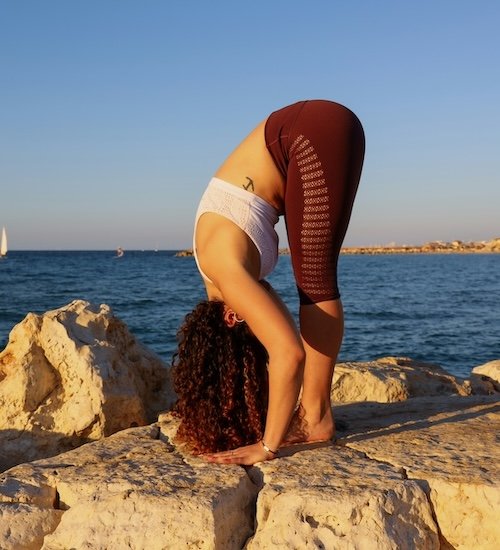The modern office worker is all too familiar with the perils of prolonged hours at a desk, repetitive movements, and poor posture. Consequently, this results in discomfort at best and sometimes severe back pain or even permanent injury. The below yoga and Pilates exercises are ideal for office workers and could help you in your quest for a supple spine. Besides keeping your body healthy; these practices also serve as a mental reprieve during a hectic workday.
Keep reading to discover simple movements you can easily incorporate into your schedule and significantly improve your wellbeing in just a few minutes each day.
back and neck pain are common ailments in office environments
Why Office Workers Experience Back Pain
It is easy to assume that physical labour jobs are the primary culprits of back pain. However, office environments contribute to this issue as well, and maybe even more...
According to a medical journal, it's common for people who work in offices to experience neck and lower back pain. In fact, in just one year, as many as 69% reported neck pain and up to 51% reported low back pain.
Understanding the root causes can help you take proactive measures. Here are five reasons why you might experience back or neck pain:
Prolonged Sitting: Long hours in chairs strain the back, and our bodies aren't designed for such extended periods of inactivity.
Ergonomic Inadequacies: Unsuitable desk set-ups can force you into uncomfortable positions, leading to poor posture.
Repetitive Movements: Actions like typing without support can accumulate stress in the fingers and wrists.
Insufficient Breaks: Without regular breaks, muscles stiffen, leading to pain.
Stress: Emotional strain often manifests as tense muscles and spasms.
Understanding the causes is the first step to addressing back pain in office settings.
it’s important to keep your spine supple and healthy
However, in hectic office environments, taking regular breaks might not always be feasible. In open plan offices you also might struggle to find a private space to stretch.
Regardless of your office set up, try to set reminders for short stretches or walks. It's about consistent movement, no matter how brief it may be. Even doing small movements for 2-5 minutes every couple of hours is better than nothing!
So, time to pivot into wellness with these yoga and Pilates exercises for office workers.
COMBAT BACK PAIN WITH THESE Yoga Exercises for Office Workers
Ease tension and improve your spinal health with easy yoga movements designed specifically for back pain relief. Whether you're a complete beginner or have been practising yoga for years, these poses will offer immediate comfort and long-term benefits.
Cat-Cow for Spinal Mobility
The cat-cow stretch, with its rhythmic and flowing motion, serves as a revitalising exercise for office workers, particularly after extended periods in a seated position. This move alleviates spinal tension, promotes enhanced flexibility throughout the neck and back, and is ideal for resetting your posture during short breaks.
How To Do It:
Start on your hands and knees in a tabletop position.
Align your wrists under your shoulders and your knees under your hips.
As you inhale, arch your back, lift your tailbone and look forward whilst broadening the chest (cow position).
Exhale as you round the spine, and tuck your tailbone under whilst pushing shoulders to sky (resembling an angry cat).
Tips:
Coordinate your breathing to increase both physical and mental relaxation.
You can also do this seated.
Duration:
1-2 minutes, or 5-10 breath cycles.
Hip Flexor Stretches for Office Workers
Hip flexor tightness is a common issue for those who sit for extended periods. Both active and restorative stretches can help alleviate this discomfort.
Lizard Pose (Active Hip Flexor Stretch)
The Lizard Pose effectively opens up and stretches the hips that often tighten from prolonged sitting. This pose also strengthens the leg muscles - especially when keeping the back knee lifted - and enhances overall flexibility while reducing tension in the lower back, a frequent concern for office workers.
How To Do It:
Start in a tabletop position.
Bring your right foot to the outside of your right hand.
For a more active stretch, lift the back knee away from the floor.
Optionally rest on forearms for a deeper stretch, or use yoga blocks under hands for more support.
Tip: For a gentler stretch, use a cushion under the back knee, especially for beginners.
Duration: Hold for 5-10 breaths, then switch sides
Lizard pose not for you? Try a low lunge instead by placing blocks under your hands on either side of your front foot, and keep the back knee on the floor. No blocks in the office (we get it!), place your hands on your front thigh for support.
Low lunge - similar to Lizard Pose only with your hands on either side of front foot or supported on your thigh.
Supported Bridge Pose (Restorative Hip Flexor Stretch)
The Supported Bridge Pose targets the hip flexors, which are prone to shortening and tightening due to extended periods of desk work. This pose also offers gentle decompression for the lower back and spine. Moreover, its relaxing nature promotes stress relief, making it an excellent option for a brief midday pause.
How To Do It:
Lay on your back with your knees bent and feet flat on the ground, hip-width apart.
Elevate your hips and place a yoga block or stack of books under your sacrum (the flat bone at the base of your spine) to make this pose restorative.
Relax your arms by your side or overhead for an added chest stretch.
Tip: Adjust the block's position for comfort, ensuring no pain or discomfort.
Duration: Hold for 5-10 breaths, allowing your body to relax onto the support.
Pilates Exercises for Office Workers For A Strong Back
Strengthen your back and core with these targeted Pilates exercises. A strong back not only alleviates discomfort but also sets the foundation for a healthier, more active lifestyle.
Pilates ‘SUPERMAN’ with elbows BENT for Strengthening Back Muscles
Pilates 'Superman' strengthens the back muscles, improve posture, and also helps to counteract the forward hunch that is common in office workers. This exercise boosts spinal mobility by engaging the entire posterior chain, from the glutes to the shoulders.
How To Do It:
Lie face down on a mat, arms bend by your side (cactus arms) and legs straight back.
Keep a neutral neck, eyes looking slightly downward.
Press the tops of your feet into the mat, firming through the quads.
On an exhale, life your head, chest & arms away from the mat whilst keeping a long neck, all the while maintaining controlled movements.
Hold for a moment, and lower your head down. Repeat the pattern while engaging your core for back protection.
Tip: For added intensity, hover both arms and legs above the mat simultaneously.
Duration: Aim for at least 30 seconds to a minute, depending on your comfort level.
Superman (with elbows bent) helps strengthens your back core and corrects your posture
V Seats for Core and Hip Flexor Strength
This yoga & Pilates-inspired pose is excellent for targeting the hip flexors and core muscles.
How To Do It:
Sit on the floor with knees bent and feet flat/or heels touching the mat.
Slightly lean back and engage your core, keeping a straight (not rounded) spine.
Elevate both feet, aligning your shins to be level with the floor for your ‘tabletop’ legs.
Extend your arms straight in front of you for balance.
Hold this "V" position, keeping the core engaged and the spine straight.
Tip: For an added challenge, extend one leg at a time or both legs simultaneously.
Duration: Hold for 20-30 seconds, building up to longer durations.
‘‘V’’ seat for a strong core
Strengthening and Stretching the Lower Body
Additionally, remember to consider the role your lower body plays in back health. It is important to strengthen and stretch your legs, hips, and glutes to keep your low back supple and free from strain. Try the below exercises to support a strong, pain-free back.
Glute Stretches and Strengthening Exercises
Strong and flexible glutes are vital for overall lower body function and posture, and for reducing the risk of injuries. For office workers, incorporating simple but effective exercises like squats and clams can counter the long-term effects of sitting.
Squats and Clams: A Two-in-One Routine
Here's how you can seamlessly incorporate these exercises into your day:
SQUATS:
These target your glutes, quads, and hamstrings.
How To Do It:
Stand with feet shoulder-width apart, both feet firmly grounded on the floor
Bend the knees to squat down, try to keep the weight into your heels
Squeeze your glutes to come back to standing, and repeat
Tip: Add some pulses at the bottom of your squat to strengthen your glutes even more.
Duration: 3 sets of 10-15 reps.
Squats are great for strengthening your glutes
CLAMS:
These focus on strengthening glutes and improving hip mobility.
How To Do It:
Lie on your side, legs stacked and knees bent
Keep the heels glued together and lift the top leg away from the bottom leg, while keeping your hips stacked
Slowly lift and lower the top leg using controlled movements
Lift out of your lower side waist to lengthen your spine and keep your spine neutral
Tip: A resistance band above the knees can make this more challenging.
Duration: 3 sets of 12-15 reps on each side.
By integrating these exercises into your routine, you can stretch and strengthen your glutes effectively.
Pigeon Pose
The Pigeon Pose is an effective stretch for the glutes and hips and is great for anyone who spends long hours seated. It helps relieve tightness from prolonged sitting and enhances hip flexibility. The exercise is also excellent for easing lower back tension. Just be mindful and take care with your knees and hips, as deep hip stretches are not for everyone.
How To Do It:
1. Begin in a tabletop position.
2. Slide your left knee behind your left wrist, angling your foot towards the right wrist. NB: Your shin does NOT have to be parallel to the top edge of your mat!
3. Stretch your other leg back, keeping it aligned with your hip (or the long edge of your mat).
4. Either remain upright (as pictured) or lean forward over your front leg. Hold for a minute if you can, then switch sides.
Pigeon Pose (upright)
Tips:
For added comfort, especially with tight hips, use a blanket or yoga block under the forward hip.
Don’t have the space in the office? Do this standing for an added balance challenge, or take a ‘figure 4’ stretch whilst seated in your chair.
Duration: Hold for 5-10 breaths on each side.
Standing Pigeon Pose aka ‘Figure 4’ Stretch
Strengthening Hip Flexors
Contrary to popular belief, hip flexors need more than just stretching, especially if you're seated often. Strengthening them is vital for proper hip alignment & posture, and avoiding long-term hip and back issues.
movements with Resistance Bands
Using resistance bands can enhance various exercises, especially targeting the hip flexors. Place the band around your ankles or above your knees and perform movements like leg lifts, marches, or ‘‘V’’ seats with knee tucks.
How To Do It:
Place resistance band just above your knees.
Engage in exercises like leg lifts, standing marches, or seated ‘‘V’’ knee tucks.
For an added challenge, take a plank pose and do 60 seconds of mountain climbers.
Tip: Ensure the band remains taut throughout the exercises to maintain resistance and effectively work the hip flexors.
Duration: For each movement, perform 3 sets of 10-15 repetitions per side.
Strengthening and Stretching Hamstrings
The hamstrings, located at the back of the legs, can also suffer from prolonged sitting. Strengthening and stretching them can reduce the risk of injury, improve posture, and enhance overall leg function.
GLUTE BRIDGEs
Glute bridges are highly effective for strengthening the hamstrings and glutes, especially when done dynamically.
How To Do It:
1. Lie flat on your back with your knees bend, in the so-called Pilates Rest Position.
2. Press you spine into the mat by tucking your tail under, and slowly roll the spine away from the floor until you find your glute bridge.
3. Slowly roll the spine down vertebra by vertebra until your sacrum touches down.
4. Once you’re happy and feel a little warmer, continue with ‘straight spine’ glute bridges by squeezing your glutes to lift your hips up, and controlling the sit bones back down.
Tip: Lengthen the knees actively away from the hips, and press the heels into the mat to find space for the low back.
Challenge: Single leg glute bridges to work hamstrings and glutes even harder, and target pelvic stability.
Duration: Perform 3 sets of 10-15 repetitions of your ‘straight spine’ bridges.
Hamstring Stretch
Stretching the hamstrings can alleviate tightness and improve flexibility.
How To Do It:
There are many ways to stretch the hamstrings. The key is the find the best one that works for your body, always making sure you keep your low back happy.
Tips:
Incorporate hamstring stretches after your workouts or during breaks at work to reduce stiffness.
Bend your knees in a standing forward fold to protect lower back.
Use a strap around your foot if lying down to keep your neck long and relaxed.
Sit on a cushion if seated to elevate your pelvis and allow a ‘deeper’ fold, and bend the knee of the leg that you’re stretching as much as you need to.
Duration: About 5 to 7 deep breaths is great.
Desk-Friendly Yoga Poses And Stretches
For those who spend a lot of time at their desks and consequently are looking for quick and effective stretches tailored for the office environment, we've got you covered. These yoga and Pilates exercises for office workers are perfect for short breaks to reset your body and mind.
Need a little more inspiration for office yoga? We have compiled the best desk stretches for a healthy spine that you can do without leaving your chair.
REAP THE BENEFITS OF YOGA & PILATES
With these targeted exercises, relief is hopefully within reach. All exercises are a proactive approach to warding off future back issues. You'll notice better posture, less discomfort, and an overall boost in your well-being with just a few minutes per day. It's a modest time commitment for a significant improvement in your daily professional life.
Embracing Wellness in the Workspace
Want to counteract the strains of office life with accessible yoga and Pilates exercises?
In today's corporate world, prioritising employee well-being is the key to sustained growth, boosting morale, and reducing absenteeism. By introducing yoga & Pilates to your staff in Melbourne you can alleviate physical discomfort, enhance mental well-being, and strengthen team unity.
If you are ready to take your team's wellness to the next level, feel free to contact us for custom-designed yoga and Pilates classes in Melbourne. Designed for office workers, we’ll ensure our wellness sessions meet your organisation's needs.
Note: Consult a healthcare provider before starting new exercises, especially if you have existing conditions.















